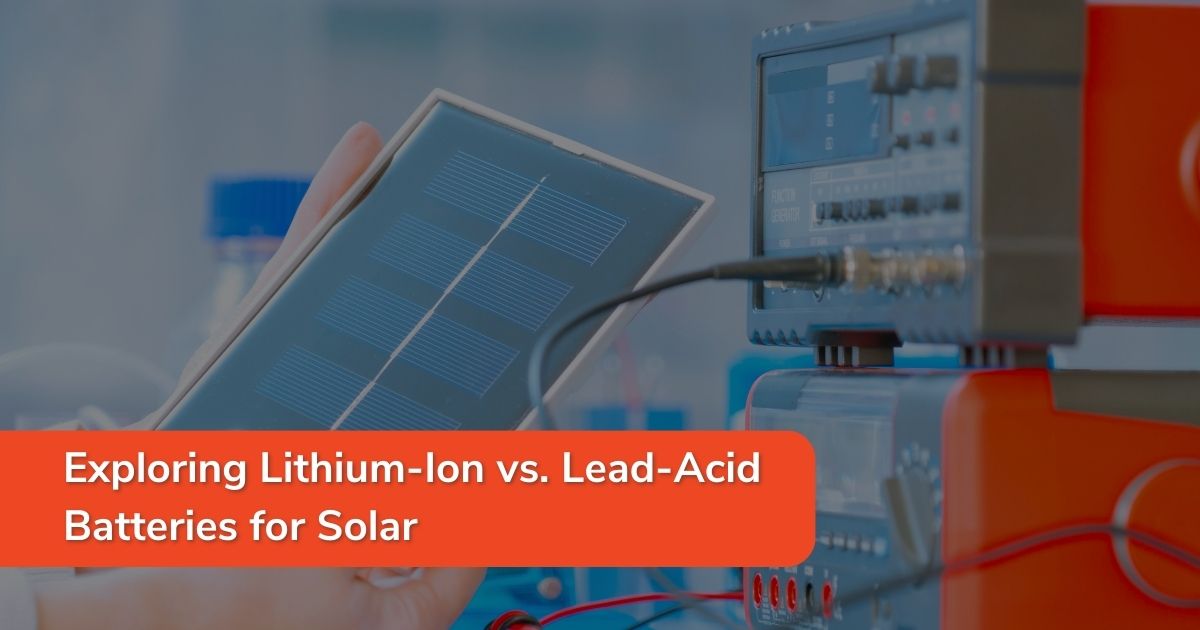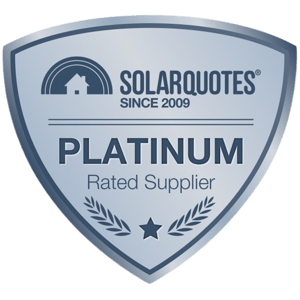Exploring Lithium-Ion vs. Lead-Acid Batteries for Solar

Choosing the right battery for your solar energy system is a crucial decision that can have a lasting impact on your system's performance and your long-term energy goals. As solar energy gains popularity across Australia, the comparison between the two primary alternatives in energy storage becomes increasingly significant. This discussion revolves around the choice between Lithium-Ion batteries, such as Tesla Powerwall and SolarEdge Home battery, and Lead-Acid batteries.
Let's delve into the details to help you make an informed decision tailored to your needs and environmental concerns.
Lithium-Ion Batteries: The Pinnacle of Solar Storage
When it comes to Lithium-Ion batteries and solar energy, the buzzword is efficiency. These batteries have set a new standard in energy storage technology, and for good reason.
Advantages of Lithium-Ion
High Energy Density
Compared to Lead-Acid batteries, Lithium-Ion batteries can store more energy per unit volume. This high energy density is a game-changer for homeowners with limited space or those aiming to store a large amount of solar energy for later use.
Longer Lifespan
The durability of Lithium-Ion batteries is impressive. They can withstand thousands of charge cycles, potentially outlasting the solar panels they support. Their resilience makes them a cost-effective option in the long run.
Faster Charging
Lithium-Ion batteries can be charged at a significantly faster rate than Lead-Acid counterparts, making them more effective at capturing and storing the intermittent energy produced by solar panels.
Disadvantages of Lithium-Ion
Higher Initial Cost
The downside of Lithium-Ion technology is the initial investment, which can be quite steep. However, the plummeting prices due to technological advancements are making them more accessible over time.
Temperature Sensitivity
Extreme temperatures can degrade the performance of Lithium-Ion batteries. While some models come with built-in temperature control, this is a factor to consider, particularly in the Australian climate.
Lead-Acid Batteries: Traditional Reliability
Lead-Acid batteries have been the go-to for solar energy storage for decades, and they still hold their own against their newer, flashier Lithium-Ion rivals.
Advantages of Lead-Acid
Lower Initial Cost
Perhaps the most significant advantage of Lead-Acid batteries is their cost. The lower upfront investment can be an attractive proposition for those on a tighter budget or for whom immediate affordability is a priority.
Wide Availability
Lead-Acid batteries are ubiquitous, with a robust infrastructure designed to support them. This means easier access to replacement parts and a wider network of service providers.
Tolerance to High Temperatures
Unlike Lithium-Ion batteries, Lead-Acid batteries are less likely to be negatively affected by the hotter Australian climate. This can translate to greater operational stability, especially in regions with extreme weather.
Disadvantages of Lead-Acid
Lower Energy Density
One of the main drawbacks of Lead-Acid batteries is their larger size and weight for the same energy storage capacity provided by Lithium-Ion batteries. This can limit their use, particularly in residential settings with space constraints.
Shorter Lifespan
Lead-Acid batteries typically offer fewer charge cycles than Lithium-Ion batteries, which means more frequent replacements and a potentially higher long-term cost of ownership.
Slower Charging
The charging speed of Lead-Acid batteries can be a sticking point when it comes to efficient use of solar power, especially during periods where rapid energy storage is crucial.
Critical Factors to Weigh
The decision between Lithium-Ion and Lead-Acid batteries isn't just about the technology; it's about finding the best fit for your unique scenario.
Cost
Evaluate not only the initial cost but the Total Cost of Ownership (TCO) over the battery's lifespan. Consider maintenance, replacement, and energy savings when making your calculations. Additionally, it's crucial to explore available government rebates or interest-free loans for solar battery storage, as these incentives can significantly impact the overall financial equation.
Energy Efficiency
Higher energy efficiency means more of your solar energy is stored for use. Lithium-Ion batteries' ability to charge and discharge without significant energy loss could be a significant factor in the ROI of your solar investment.
Lifespan
A more extended battery lifespan might justify a higher upfront cost. Compare warranties and expected lifespans to determine which option aligns with your financial and environmental objectives.
Environmental Impact
For eco-conscious homeowners, the environmental impact of the manufacturing and disposal of batteries is a key concern. Lithium-Ion batteries tend to have a smaller carbon footprint, but the entire lifecycle must be considered.
Making the Right Investment in Solar Energy
The benefits of incorporating a battery into your solar energy system are increasingly clear, not only for personal energy independence but also for the health of our planet. As you explore Lithium-Ion and Lead-Acid batteries, keep in mind the unique strengths and weaknesses of each technology. Consider consulting a professional to conduct an energy audit and help you select the best storage solution. Your solar energy system should be tailored to meet your specific needs, climate conditions, and long-term sustainability goals.
It's time to take charge—literally and figuratively—of your energy future. Ready to invest in sustainable solar storage? Make sure to weigh your options carefully and don't shy away from embracing the technology that will take your solar energy game to the next level. Contact us today to help you make an informed decision on your solar and battery needs.
%20(1).png?width=265&height=96&name=www.smartenergyanswers.com.auhs-fshubfsSmart%20Energy%20Answers%20Logo%20(HIRES)%20(1).png)

.png?width=514&height=121&name=Tesla%20Powerwall%203%20(new).png)







